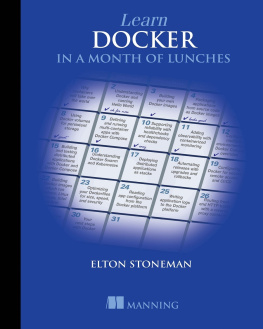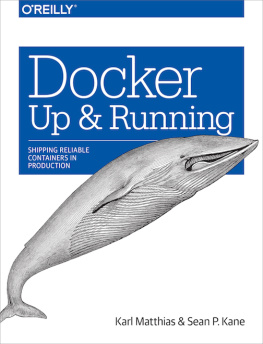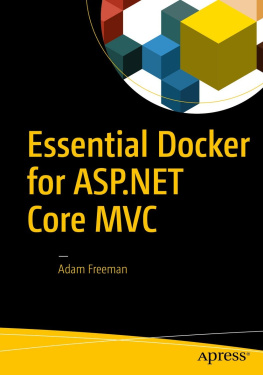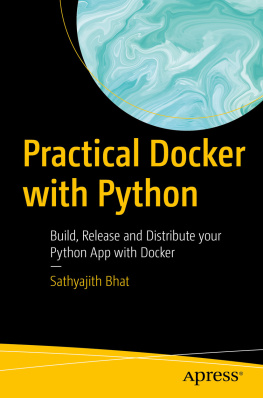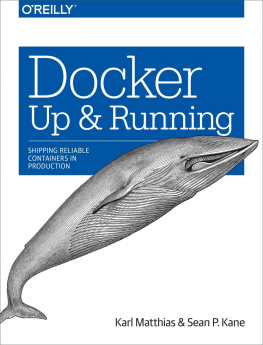
Learn Docker in a Month of Lunches
Elton Stoneman
To comment go to liveBook

Manning
Shelter Island
For more information on this and other Manning titles go to
manning.com
Copyright
For online information and ordering of these and other Manning books, please visit manning.com. The publisher offers discounts on these books when ordered in quantity.
For more information, please contact
Special Sales Department
Manning Publications Co.
20 Baldwin Road
PO Box 761
Shelter Island, NY 11964
Email: orders@manning.com
2020 by Manning Publications Co. All rights reserved.
No part of this publication may be reproduced, stored in a retrieval system, or transmitted, in any form or by means electronic, mechanical, photocopying, or otherwise, without prior written permission of the publisher.
Many of the designations used by manufacturers and sellers to distinguish their products are claimed as trademarks. Where those designations appear in the book, and Manning Publications was aware of a trademark claim, the designations have been printed in initial caps or all caps.
Recognizing the importance of preserving what has been written, it is Mannings policy to have the books we publish printed on acid-free paper, and we exert our best efforts to that end. Recognizing also our responsibility to conserve the resources of our planet, Manning books are printed on paper that is at least 15 percent recycled and processed without the use of elemental chlorine.

| Manning Publications Co. 20 Baldwin Road Technical PO Box 761 Shelter Island, NY 11964 |
Acquisitions editor: | Michael Stephens |
Development editor: | Becky Whitney |
Technical development editor: | Mike Shepard |
Review editor: | Aleksandar Dragosavljevi |
Production editor: | Anthony Calcara and Lori Weidert |
Copy editor: | Andy Carroll |
Proofreader: | Keri Hales |
Technical proofreader: | Yan Guor |
Typesetter: | Dennis Dalinnik |
Cover designer: | Leslie Haimes |
ISBN: 9781617297052
I wrote this book in a barn in Gloucestershire, England. During many late nights, my fantastic wife, Nikki, kept the family running, so this book is for her and for our fabulous children, Jackson and Eris.
preface
By 2019 Id been working with Docker and containers for five yearsspeaking at conferences, running workshops, training people, and consultingand in that time I never had a go-to book that I felt I could recommend to every audience. There are some very good Docker books out there, but they assume a certain background or a certain technology stack, and I felt there was a real gap for a book that took a more inclusive approach: welcoming both developers and ops people, and both Linux and Windows users. Learn Docker in a Month of Lunches is the result of me trying to write that book.
Docker is a great technology to learn. It starts with one simple concept: packaging an application together with all its dependencies, so you can run that app in the same way anywhere. That concept makes your applications portable between laptops, datacenters, and clouds, and it breaks down barriers between development and operations teams. Its the enabler for the major types of IT project organizations are investing in, as youll learn in chapter 1, but its also a straightforward technology you can learn in your own time.
Mannings Month of Lunches series is the perfect vehicle to help you, as youll get much more from the experience of running exercises and trying labs than you will from reading the theory of how operating systems isolate container processes. This is very much a real-world book, and youll find that each chapter has a clear focus on one useful topic, and that the topics build on each other to give you a thorough understanding of how youll use Docker in practice.
acknowledgments
Writing for Manning is a real pleasure. They take great care to help you make your book as good as it can be, and Id like to thank the reviewers and publishing team whose feedback led to countless improvements. Id also like to thank everyone who signed up for the early access program, read the drafts, tried out the exercises, and provided commentsI really appreciate all the time you put in. Thank you.
I would also like to thank all the reviewers, whose suggestions helped make this a better book: Andres Sacco, David Madouros, Derek Hampton, Federico Bertolucci, George Onofrei, John Kasiewicz, Keith Kim, Kevin Orr, Marcus Brown, Mark Elston, Max Hemingway, Mike Jensen, Patrick Regan, Philip Taffet, Rob Loranger, Romain Boisselle, Srihari Sridharan, Stephen Byrne, Sylvain Coulonbel, Tobias Kaatz, Trent Whiteley, and Vincent Zaballa.
about this book
My goal for this book is quite clear: I want you to be confident about running your own applications in Docker when youve finished; you should be able to run a proof-of-concept project to move your apps to containers, and you should know what you need to do after that to take them to production. Every chapter is focused on real-world tasks and incrementally builds up your experience with Docker, distributed applications, orchestration, and the container ecosystem.
This book is aimed at new and improving Docker users. Docker is a core technology that touches lots of areas of IT, and Ive tried hard to assume a minimum amount of background knowledge. Docker crosses the boundaries of architecture, development, and operations, and Ive tried to do the same. This book should work for you, whatever your background in IT.
There are a lot of exercises and labs in the book, and to get the most out of your learning, you should plan to work through the samples as youre reading the chapter. Docker supports lots of different types of computers, and you can follow along with this book using any of the main systemsWindows, Mac, or Linux, or even a Raspberry Pi is fine.
GitHub is the source of truth for all the samples I use in the book. Youll download the materials when you set up your lab in chapter 1, and you should be sure to star the repository and watch for notifications.
How to use this book
This book follows the Month-of-Lunches principles: you should be able to work through each chapter in an hour, and work through the whole book in a month. Work is the key word here, because the daily 60 minutes should be enough time to read the chapter, work through the try-it-now exercises, and have a go at the hands-on lab. Its working with containers that will really cement the knowledge you gain in each chapter.
Your learning journey
Docker is a great technology to teach because you can easily build a clear learning path that starts simple and gradually adds more and more until you get to production. This book follows a proven path Ive used in dozens of workshops, webinars, and training sessions.
Chapter 1 will tell you how this book works, and go over the importance of containers, before walking you through installing Docker and downloading the resource files for the exercises in the book.
Next page
